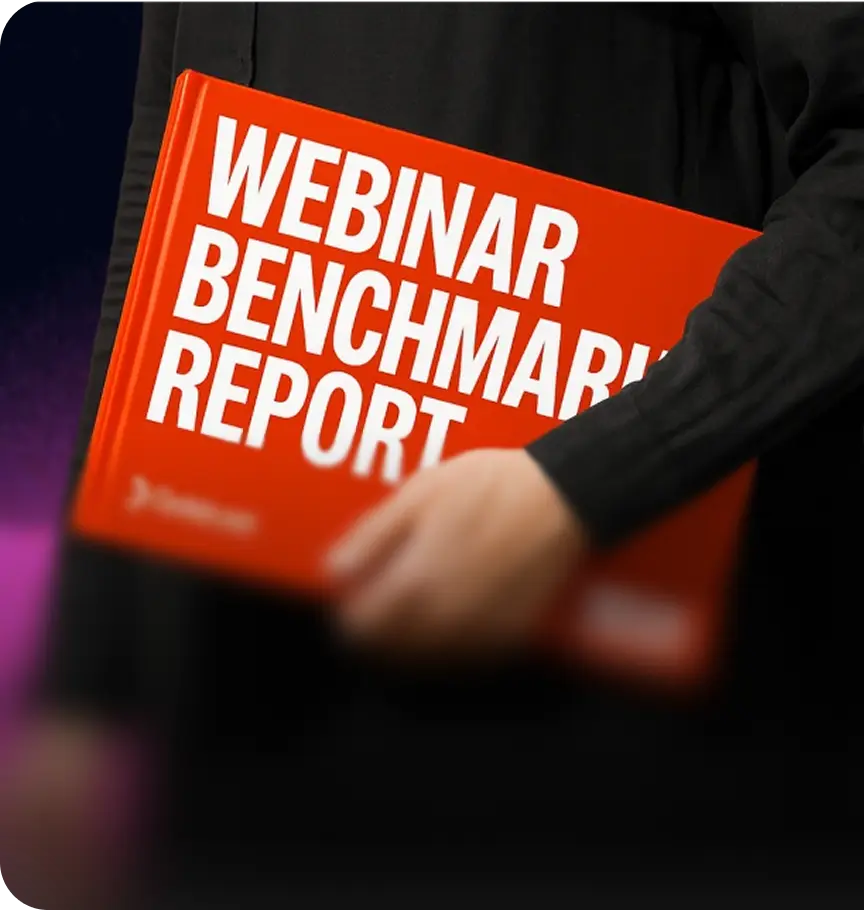2025 B2B Webinar Benchmark Report
Powered by Goldcast
Table of Contents
- About the data
- What’s a webinar?
- Webinar types
- Webinar length
- Webinar frequency
- Webinar registrants
- Webinar attendance rates
- Webinar schedule
- Webinar speakers
- On-demand webinars
- Webinar series
- Webinar title
- Webinar engagement
- Webinar repurposing
- Webinar Benchmark Scorecard
- Improve your webinar strategy
- Take the next step today
We'll get right to it: In the Goldcast platform alone, webinars grew by 225% year over year.

This explosive growth is the result of several key shifts in the B2B space. To start, the rise of AI has dramatically simplified event production and content repurposing, making it possible for businesses to ramp up their programming without adding resources.
Cross-functional adoption has also given webinars a much-needed makeover; it's common now for the sales, product, and other teams to use webinars to meet their goals. Meanwhile, improved analytics tools make it possible to clearly demonstrate ROI from webinar investments.
We've also seen a continued audience demand for bingeable video content. Because webinars can be hosted on-demand to a global audience, they're an appealing option for viewers who want flexibility when it comes to content consumption.
Videos are the best way to build mindshare — the valuable mental real estate that causes your audience to think of you when it's time to buy. And, for B2B companies, webinars are the most scalable, practical way to create high-quality video content to engage audiences.
However (there's always a however, isn't there?), because there is so much more content out there, it takes more work to stand out now. You'll have to be that much more creative and entertaining, even when your primary purpose is to inform or educate. In other words, one hour lecture-style webinars on a standard meeting platform won't cut it.
This year's benchmark report contains more data than ever before.
Together, we'll walk through relevant performance metrics so you can compare your webinar strategy to what others are doing. If you've read our past reports, you'll recognize many of the sections here and see some new info, like industry-specific webinar timing.
Want to see how this data can be used with your metrics in mind? Use our Webinar Benchmark Report GPT to see how you stack up to others.
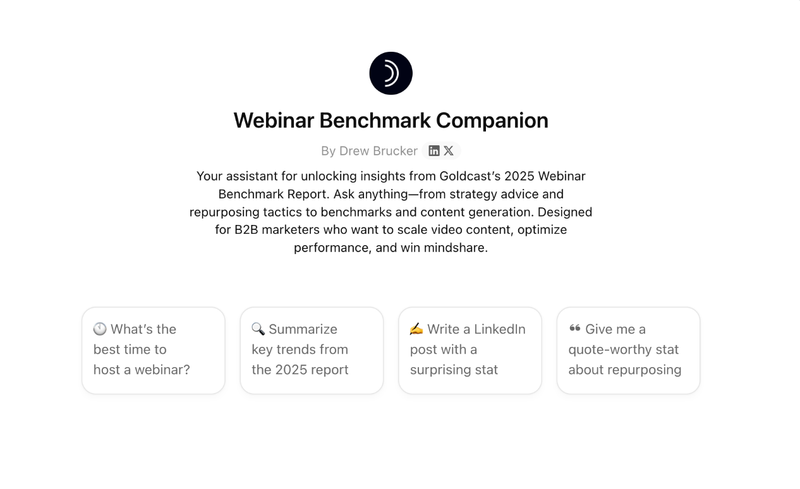
About the data
To create this report, we reviewed 19,531 webinars across 418 B2B brands for the calendar year of 2024.
Compared to last year's report (2023) — which looked at ~6K webinars put on by 300 B2B brands — this was a 225% and 39.9% increase, respectively.
We also saw big increases in the number of registrants and attendees:
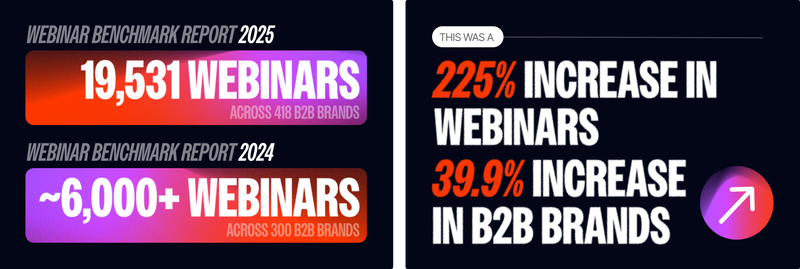
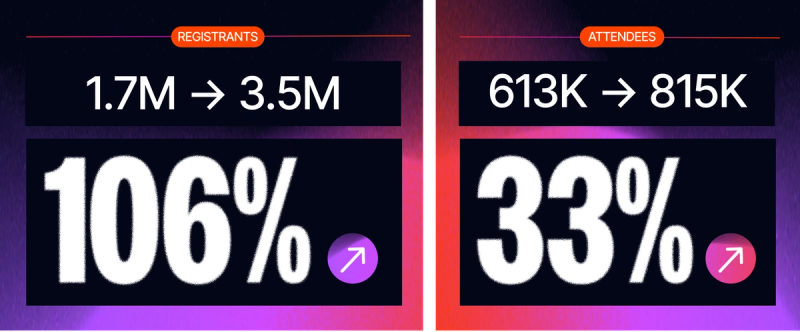
The data spanned January-December 2024, providing us with a robust amount of information to identify trends and compare metrics against prior years.
We recommend using these numbers to check in on your own webinar performance and identify areas of success and potential improvement. While your goals will be specific to your company, analyzing the average of this much data will offer valuable context for most B2B companies.
Prefer to watch the takeaways? View the on-demand event here: The 2025 Webinar Benchmark Report Revealed
What’s a webinar?
For the purposes of this report, "webinar" refers to a single-session virtual event that lasted 90 minutes or less. According to our data, the most effective webinars abide within this format — they're focused, concise, and can fit into attendees' busy schedules.
Note: Webinars as we define them here are not the same as "virtual events," which can include multi-session conferences, all-day summits, extended workshops, and other types of events. To streamline our analyses, we also excluded event series (although we'll talk about them in the report).
Webinar types
Goldcast offers three different types of webinar formats:
- Live: This is when you host your webinar in front of a live audience. Even if you record your live webinar for on-demand consumption, it falls into this category if you had an audience there during the actual event.
- Pre-recorded: You also have the ability to record your webinar ahead of time and then release it to your audience on a schedule of your choosing. There's no on-stage audience interaction, but folks can still answer polls, ask questions, and otherwise engage.
- RTMP: This refers to webinars that are streamed in/out externally from other platforms like LinkedIn or Facebook. For example, you might be hosting an event on Goldcast and want it to be available simultaneously on YouTube, so you'd use RTMP.
Live webinars remain the most popular
Here's the distribution of these webinar types from last year:

Live webinars are still the most popular format, and we think that will always hold true. People are energized by live events and the chance to engage with hosts, presenters, and other attendees.
That said, pre-recorded events are inching higher in popularity and have their own set of unique benefits.
Why run a pre-recorded webinar?
AI and other tech innovations are making things easier than ever for event producers. They are especially helping produce pre-recorded content for events. Pre-recorded events can work well in many scenarios:
- Unavailable or anxious speakers: When you've got busy speakers (or folks who are too nervous to speak live), pre-recording is the way to go.
- Hybrid events: Use pre-recorded segments to complement IRL segments for your hybrid events.
- Complex approval processes: Particularly in highly regulated industries, pre-recording gives you the ability to have multiple people review the material before it goes live.
- Internal training and enablement: Need to conduct multiple sessions for your org? Pre-record once, and ensure consistency across viewings.
- Pre-event content editing and prep: You can't exactly edit out a misspeak when it happens live, but you can edit videos if you get them ahead of time.
- Multi-region time zones: With pre-recorded events, you can run the same event multiple times without stretching speaker capacity.
Remember: Pre-recorded webinars aren't the same as on-demand webinars, which we'll talk about later on. Pre-recorded events are meant to give the feel of the live event, without requiring the speakers to be present on the day of the event. There are many ways for attendees to engage throughout the pre-recorded event — something that on-demand webinars can't offer.
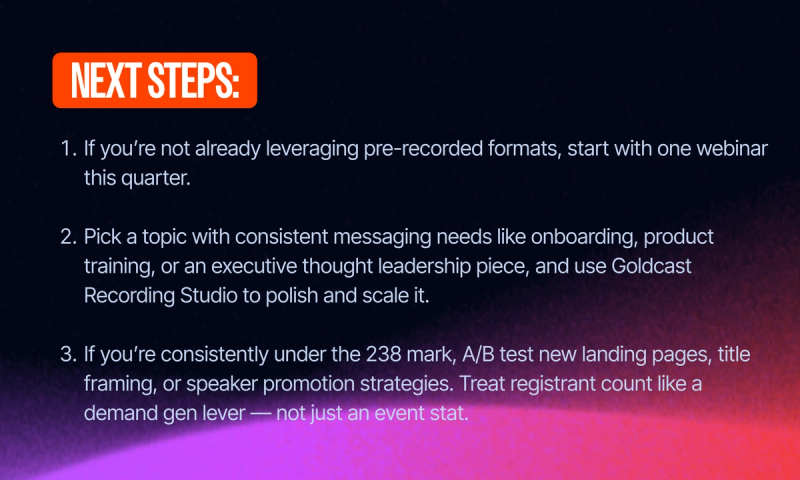
What types of webinars are pre-recorded?
We did some digging into the types of webinars that are pre-recorded, and found that these types of formats and topics are most common:
- Onboarding & customer education
- Roundups or trend reports
- Product demos and tutorials
- Product roadmap presentations
- Release announcements
- Trainings
- Thought leadership
- Case studies & customer stories
These webinar topics make sense for a pre-recorded format. For example, your thought leaders are busy; they likely don't have time to host multiple sessions just to deliver the same information.
In these situations, pre-recorded sessions can be the best of both worlds, offering your audience the chance to engage and network while ensuring consistency and saving time on the backend.
Webinar length
We analyzed webinars up to 90 minutes long to understand how duration impacts engagement and attendance.
How long is a typical webinar?
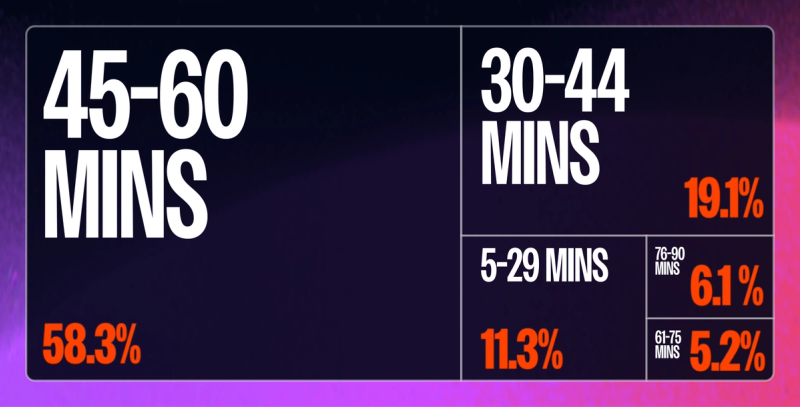
As was true last year, the 45-60 minute webinars are still the most popular length.
Interestingly, we saw there are fewer long-form webinars being produced (with 21% of total webinars being 61+ minutes last year, and only 11% this year).
There's also been a significant increase in the number of short webinars (29 minutes or less). Last year, these short-form webinars represented 3% of the total number, and this year, they're 11.3%.
Here's a real-world example: The AI Marketing Alliance hosted an event called "Building an AI-Ready Marketing Team." This event had 45 minutes of content and 15 minutes for Q&A and featured three speakers, polls, and lots of engagement opportunities. We saw a 45% attendance rate and an average watch time of 48 minutes — nearly the entire event!
Keeping webinars to the 45-60 minute length aligns with the average watch time of 29 minutes. People are busy and often fitting webinars into a busy day. If you frontload your important info (and some engagement opportunities) into the first 30 minutes, you'll reach almost everyone who attends. Then, folks can check out the on-demand later to see what they missed.
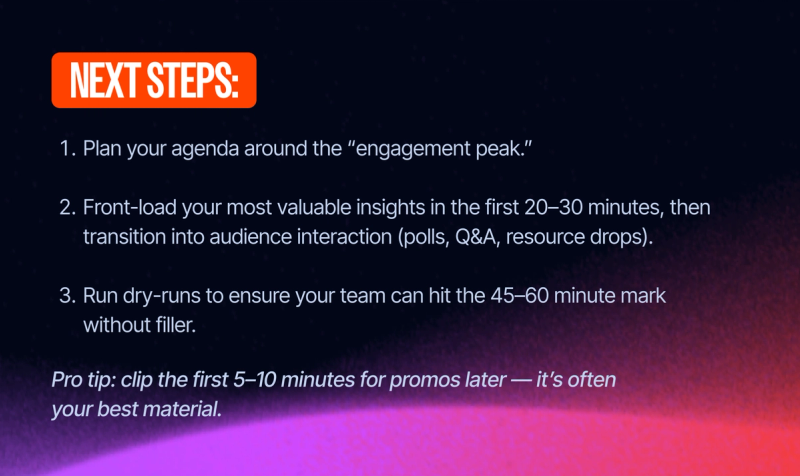
Average webinar length by industry
Even though longer webinars seem to be happening less, this appears to be industry dependent.
Take a look at the average duration by industry:
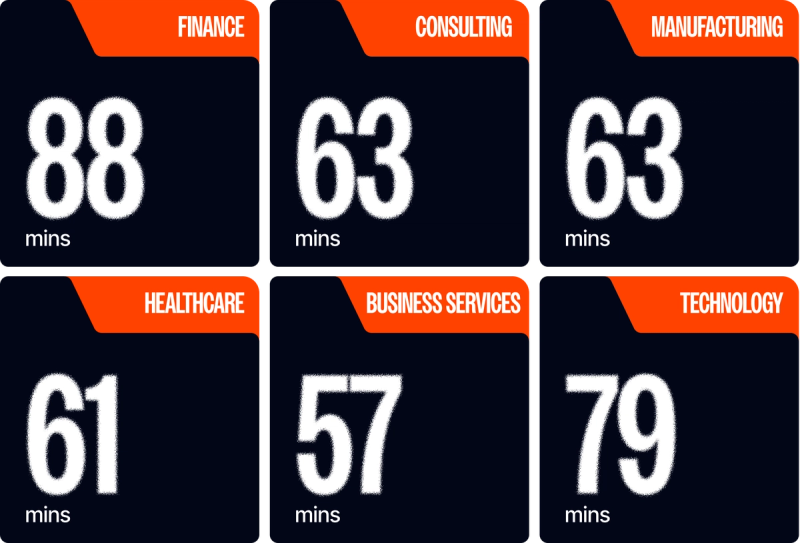
As you can see, the more complex and highly regulated the subject matter, the longer the run time. Hosting a 1.5 hour webinar may not make sense for a B2B agency, but for a financial services company, the extra time allows them to deep dive into technical content with their audiences.
This is a great reminder that while the benchmark can be useful in most cases, the ideal for your company will depend on your specific industry, needs, and audience expectations.
Webinar frequency
As with last year, the data continues to show a clear trajectory of increasing webinar production.
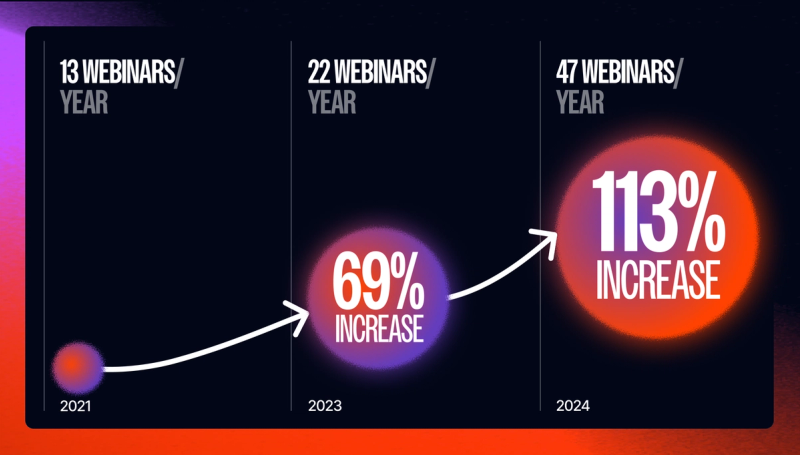
That's right: Companies are currently hosting, on average, nearly four webinars every month.
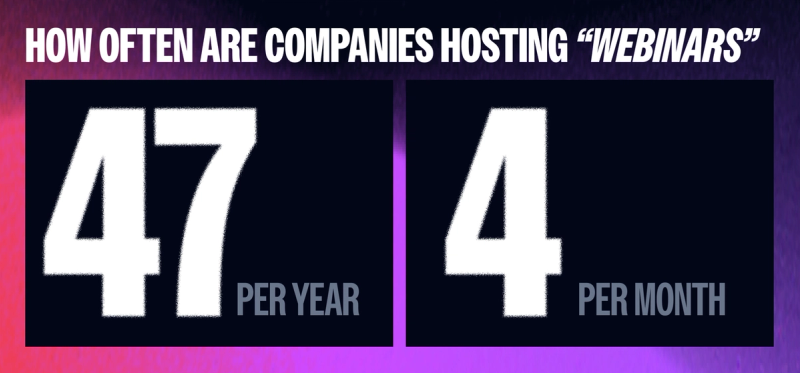
Webinars have become core components of the B2B content marketing engine, and they're not going anywhere.
There are many drivers of this growth:
- Content ROI and improved measurement: Advanced analytics tools now provide clearer insights into webinar performance, making it easier for teams to prove what's working.
- The rise of AI: We can't talk about scaling without mentioning AI. It's now easier to produce events and get the most runway out of content, thanks to AI-powered repurposing tools like Content Lab. (Psst: We'll talk about repurposing later in the report, too)
- Growing demand for video content: People can't get enough video, and webinars are one of the best ways for B2B brands to produce compelling videos at scale.
- Higher quality at scale: Tools make hosting engaging events a breeze, while Recording Studio and Content Lab allow you to record and repurpose high-quality videos, faster.
- Broader use cases: Webinars aren't an hour-long sales pitch anymore. They're now being used for internal meetings, training, product demos, customer education, and so much more.
- Cross-functional adoption: It isn't just the marketing team putting on webinars; now, sales teams use webinars to drive deals, product teams host webinars for feature reveals, and customer success teams get folks onboarded via webinars.
- Streamlined tech stacks: End-to-end solutions handle everything, from pre-event recording, to hosting the actual webinars, to repurposing. This reduces the cost and time investment historically associated with webinars.
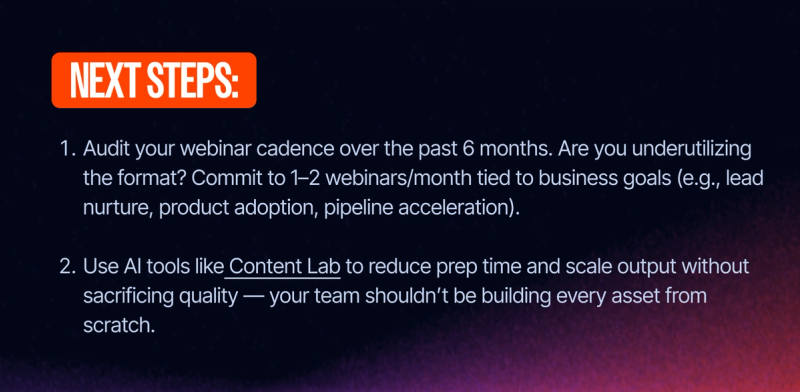
Webinar registrants
Webinars boost brand awareness, expand your reach, produce valuable video content that can be repurposed into tons of other content, and more. And people are showing up for them in droves.
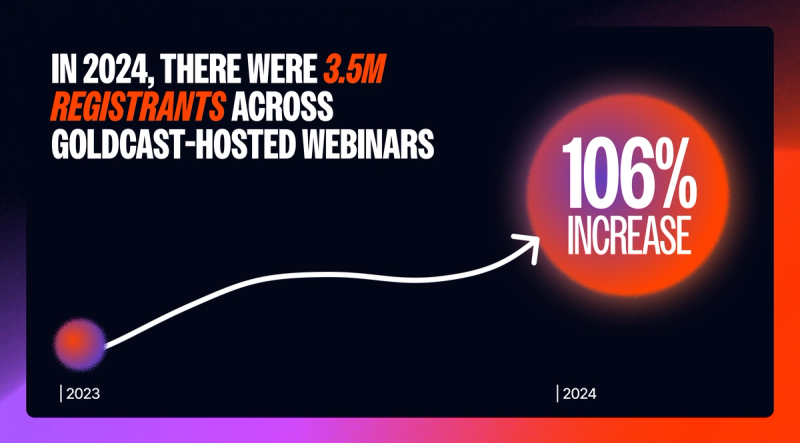
So, what does that mean in terms of how many people signed up for each webinar? What number should you expect in terms of registrations?
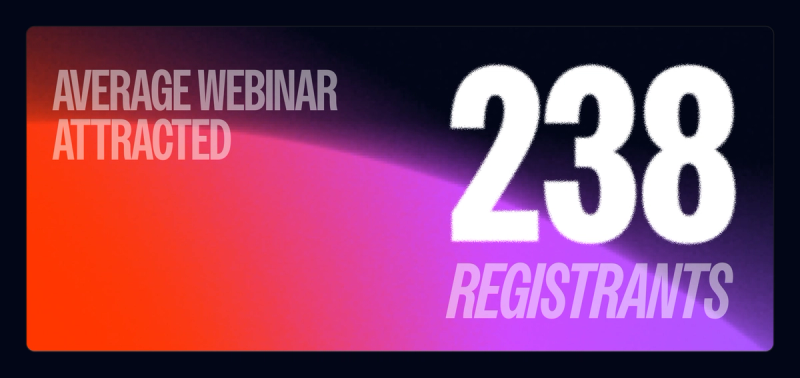
This is a solid benchmark for measuring webinar performance, but keep in mind that many factors influence final numbers, including:
- What day and time your webinar happens (we'll analyze schedules and timing shortly)
- The content you're presenting and its relevance
- Promotional efforts
- Your industry and market size
- The reputation and reach of any partners or speakers
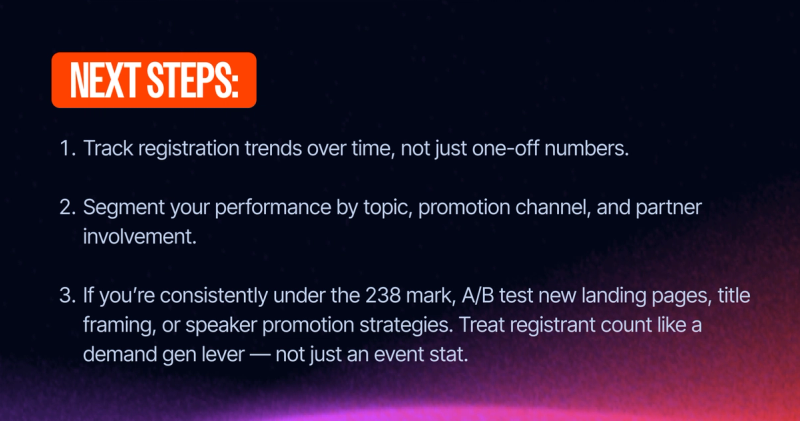
The "Highest Registrants Award" goes to… 🏆
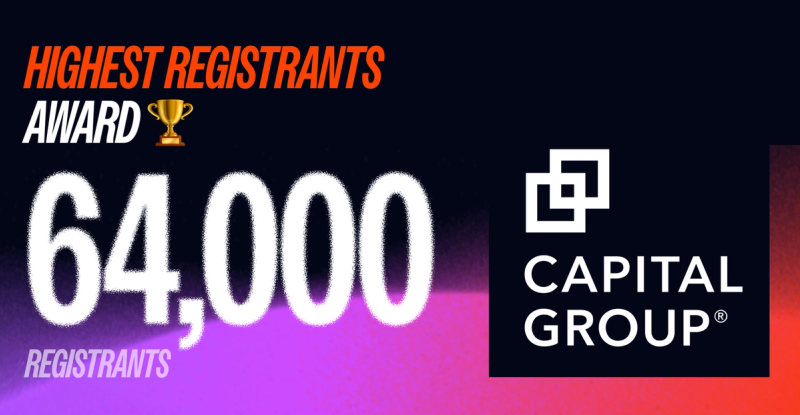
Clocking in with the highest number of registrants for a single webinar — with more than 64,000 registrants — is Capital Group's 2025 Outlook, which happened on Thursday, December 12, 2024. Pretty impressive.
A few reasons this webinar was so popular:
- It's part of an established series, which tends to draw a built-in repeat audience
- It offered valuable, timely information about the year to come
- It happened in the evening after work hours, when more people were free to attend
- The speaker panel had a combined 80+ years of experience, giving their insights weight and value
The event lasted two hours and people were very engaged, with 232 questions being asked in the chat and most folks staying through the first hour.
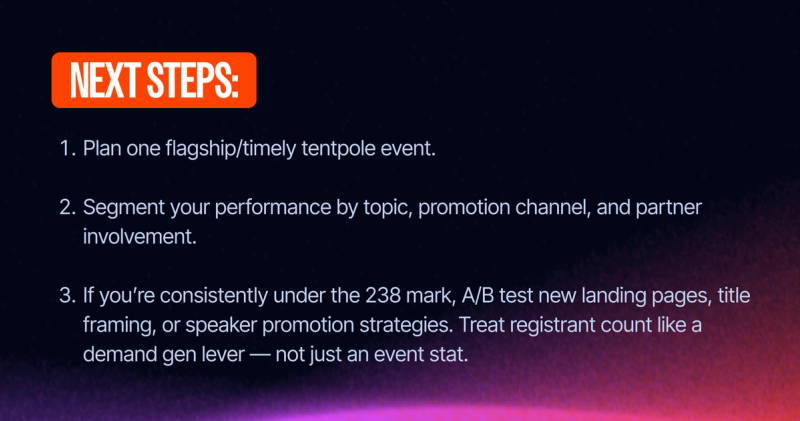
Webinar attendance rates
High registration numbers are exciting, but getting people to show up on the day of the event is what really matters in the long run. We saw an encouraging uptick in webinar attendance this year.
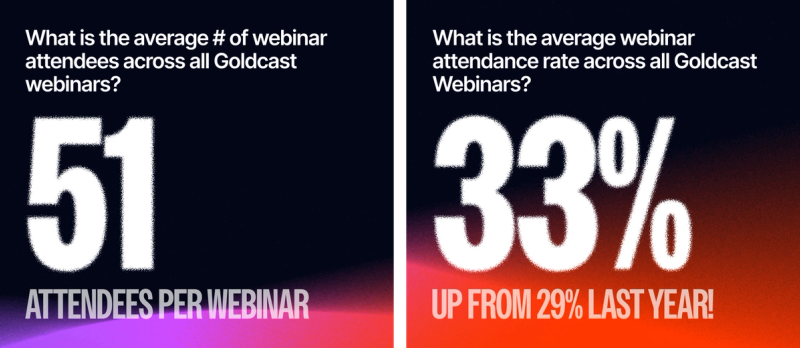
On average, we saw a 33% attendance rate when you compare how many people signed up vs how many people showed up. This number has gone up since our last report, when about 29% of people who registered also attended.
We have seen companies get better at using audience data to send more targeted, personalized invitations. This increases the relevance of each event to the invitee, boosting the chances they'll show up.
We've also seen a widespread use of short, engaging video teasers and social media recaps, improving event visibility and pushing more people to attend (see Goldcast’s Content Resurrection example below).
Now, you can probably guess which event had the most attendees.
It likely won't surprise you that Capital Group's 2025 Outlook event had the most attendees, with almost 4K people joining the live session. Many people also signed up in order to access the valuable on-demand content afterward as well.
Webinar schedule
Through the years, we've seen that most webinars happen mid-week, and that's still true. Thursday is the most popular day to host a webinar, and Tuesdays and Wednesdays aren't far behind.
What days of the week are most — and least — popular for webinars?
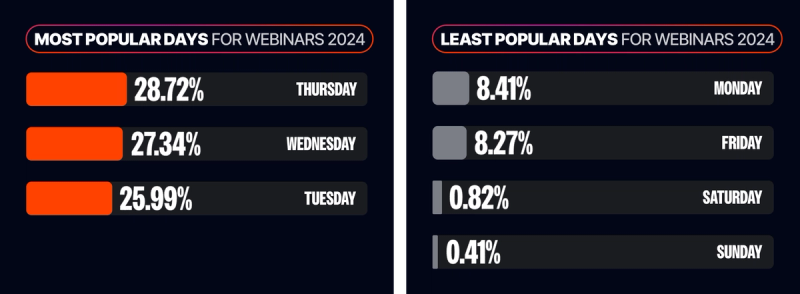
Mid-week webinars seem ideal due to typical work rhythms. People tend to use Mondays to map out priorities for the week, and Fridays are increasingly becoming off-limit for meetings. Scheduling Tuesday-Thursday should give you the best chance of reaching the most people, right?
We thought so too … until we looked more into how scheduling impacts attendance rates. Keep reading to see how the day of the week can affect how many people show up.
Attendance by day of the week
We know mid-week webinars are the most scheduled, but are they also the most attended?
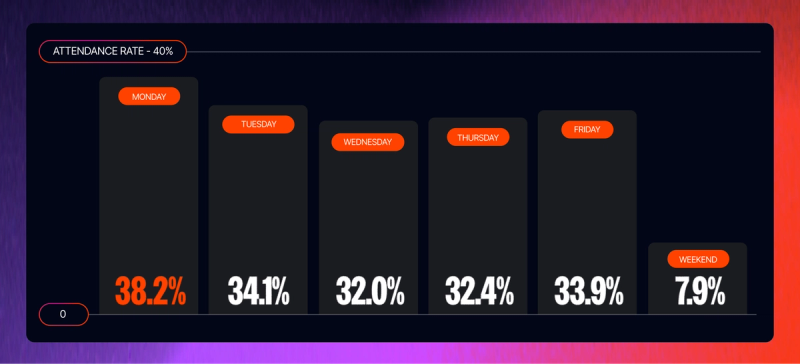
Notice that although Wednesdays and Thursdays are when most webinars are scheduled, Monday and Tuesday actually generate more attendees than either of those days.
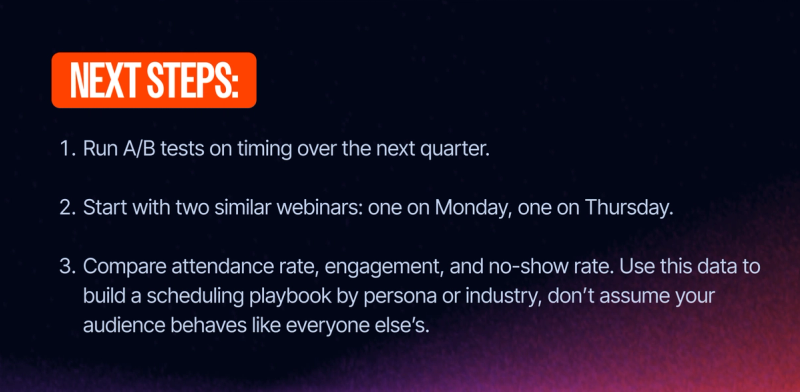
Does the time of day matter?
This year, we made some striking discoveries about the optimal times to host webinars, depending on what industry you're in.
Tech vs. non-tech industries
The overall attendance rate is 33%, but we saw that certain day and time slots significantly outperformed this benchmark.

For tech companies, the best time for high attendance was Friday, starting at lunchtime, while non-tech companies saw a higher attendance rate on Friday mornings.
Industry-specific timing
When we drilled down into more specific industry data, we saw attendance rate was highest at these days and times:
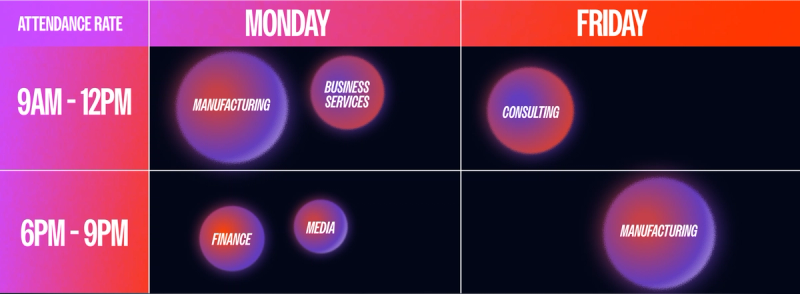
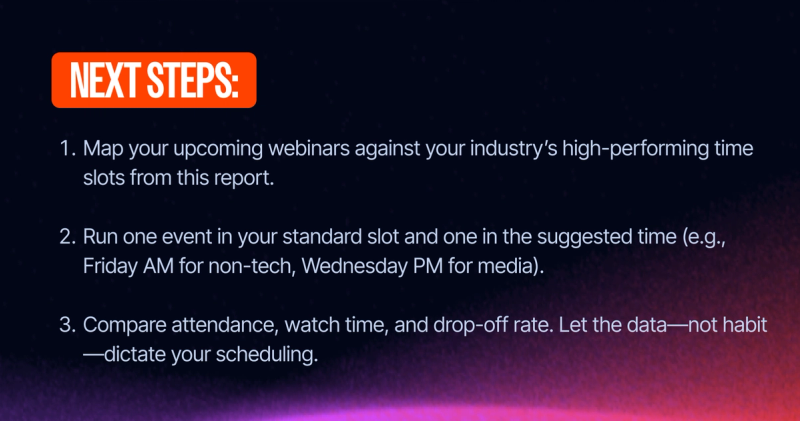
Webinar speakers
New data point alert: we reviewed the total number of webinar speakers this year, across all events.
In 2024, a total of 72,643 experts spoke across events — an average of 4 speakers per event!
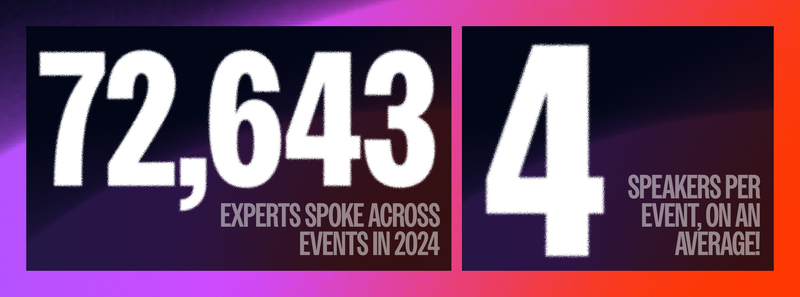
This multi-speaker benchmark shows that webinars are more of a collaborative conversation these days. Audiences like variety, and they want to hear from the strongest voices in the industry. Remember Capital Group's event? They had three speakers, putting them right near the benchmark.
There are so many benefits to including more than one speaker:
- You lessen the risk of fatigue, both for your audience and the speakers
- You can approach complex topics from multiple angles and drive discussion
- When things feel more like a conversation, engagement goes up
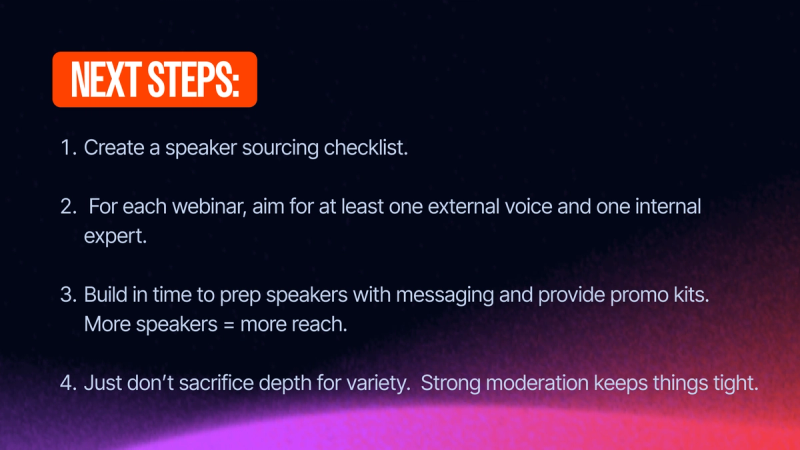
On-demand webinars
The availability of on-demand content has dramatically increased since last year, reflecting a shift in how companies think about webinar value.
How many webinars are available on demand?
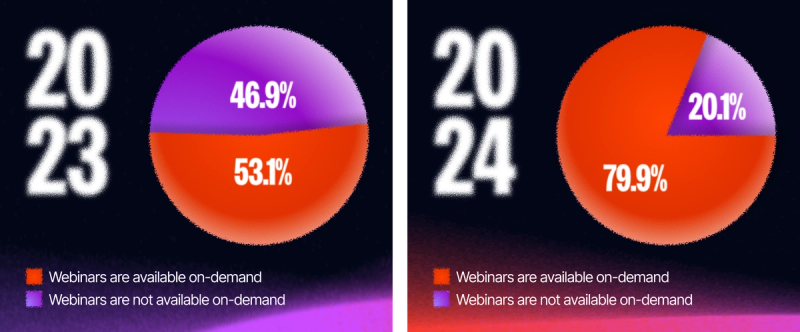
Today, nearly 80% of webinars are available after the event ends. Imagine where we'll be next year?
Why on-demand content is surging
The rise in on-demand content is influenced by these factors:
- Your audience is global, and they're busy. Registrants want to consume content on their own time, and you don't gain anything by withholding it.
- Webinars are being used to build evergreen content hubs. Teams are now thinking beyond the live event and well into the future.
- Marketers recognize the value of webinars. You've put a lot of time, energy, and money into your webinar. On-demand allows you to get more value from it in the long run.
- Executives want to see max ROI from events. Budgets keep getting tighter, and C-suite leaders also want to see how marketers are extracting the most value from the content they do produce. Plus, modern analytics tools can prove the return on webinars and on-demand content.
- Technology expedites the process. Tools like Content Lab streamline post-event editing, repurposing, and distribution, saving you time on the backend and making it possible to scale.
On-demand viewing patterns
After the event is up on the on-demand page, a healthy number tunes in to watch, including event registrants who may or may not have attended the live event.
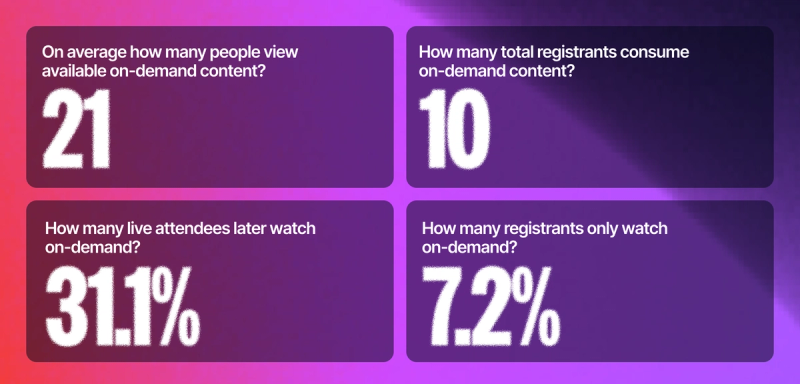
The fact that nearly a third of attendees go back and watch on-demand content after experiencing it live is incredible. This behavior suggests that people are reviewing key takeaways, catching up on parts they didn't fully get the first time, and sharing segments with others — every event producer's dream.
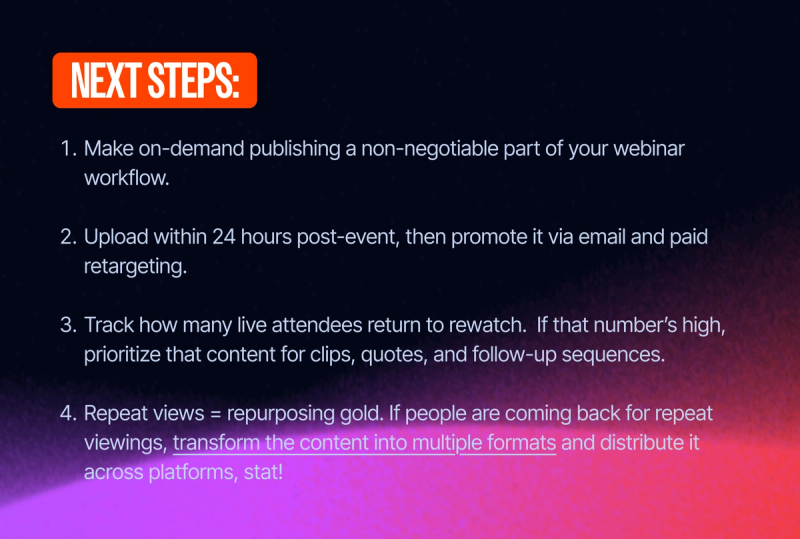
Webinar series
Last year, we saw an uptick in serialized content, and that trend continued. People love TikTok and YouTube Shorts, and a series brings your audience the same type of consistent, engaging content they crave.
In 2024, 26% of all webinars were part of a series.

This is huge. More than a quarter of all webinars were part of a series, showing that companies understand it takes more than single, random touchpoints to build Mindshare with customers.
Benefits of hosting a webinar series
We all know the B2B buying cycle is longer than ever, and your goal is to stay relevant throughout. Webinar series help you build lasting relationships and continue delivering valuable content to your prospects.
Here are some specific benefits of series:
- Ongoing audience engagement: Series create anticipation with viewers as they come to expect your content. This builds more momentum and deeper relationships than single webinars typically can.
- Build thought leadership: Consistent, relevant episode topics establish you as a go-to on certain topics within the industry.
- Tell bigger stories: Interested in a complex topic or layered story? Series are a great fit.
- Boost attendance and retention: Series attendees tend to stick around over time, attending multiple sessions and spreading the word about your content.
- Easier planning and promotion: Once you've got your format and rhythm down, you just have to come up with episode topics. Your content calendar and promo campaigns become more predictable, and you'll always have content to repurpose.
- Rich repurposing opportunities: Speaking of repurposing, series generate so much valuable video content. Turn it into social clips, videos for email campaigns, teasers for future episodes, and more.
- Co-marketing partnerships: Series provide natural opportunities to work with complementary brands and industry leaders, which can widen your reach.
Name your series accordingly
In our last report, we saw that webinars with the word "series" in the title had a higher average attendance rate. This year, that held true once more.
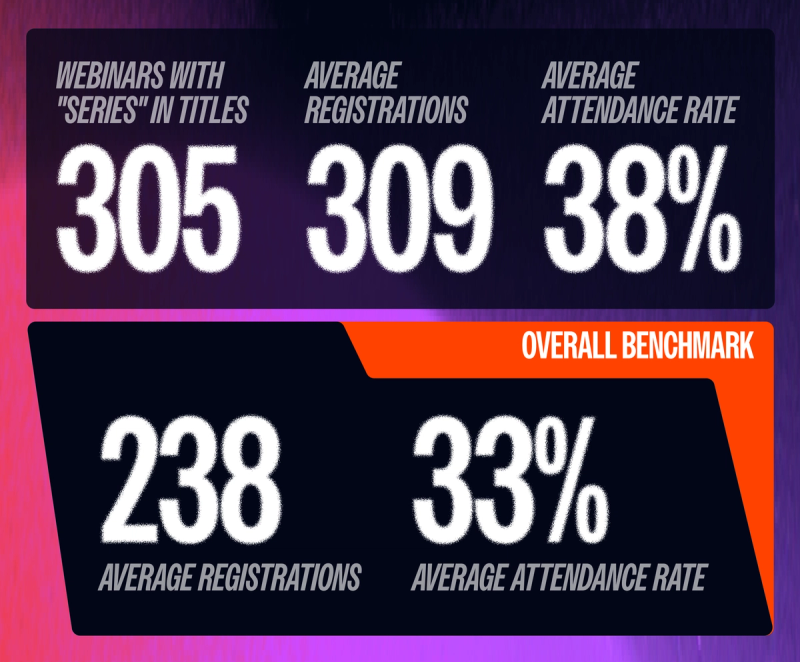
You can see that using the word "series" to name your content may lead to higher registration and attendance rates (30% more registrants sounds pretty good to us!).
This suggests that audiences actively want series content, and they'll readily sign up for clearly branded series. When they register for a series, people know that they'll be able to look forward to even more engaging, informative content to come.
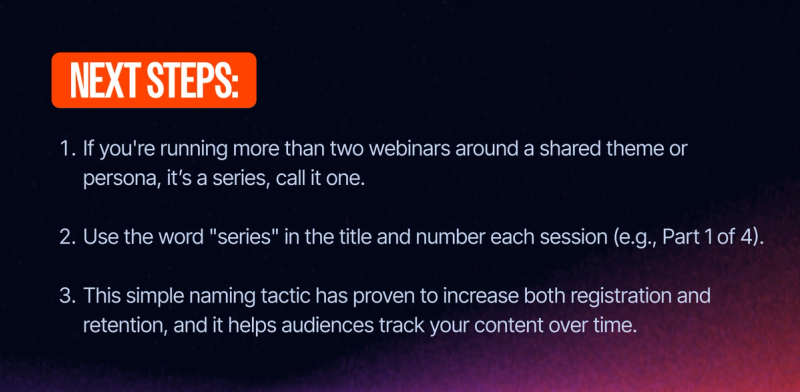
Webinar title
There's been a fascinating reversal here — for the last few years, using the word "webinar" was associated with fewer registrants and attendees, and our advice was to stay away from doing this.
However, this year's data told a dramatically different story.
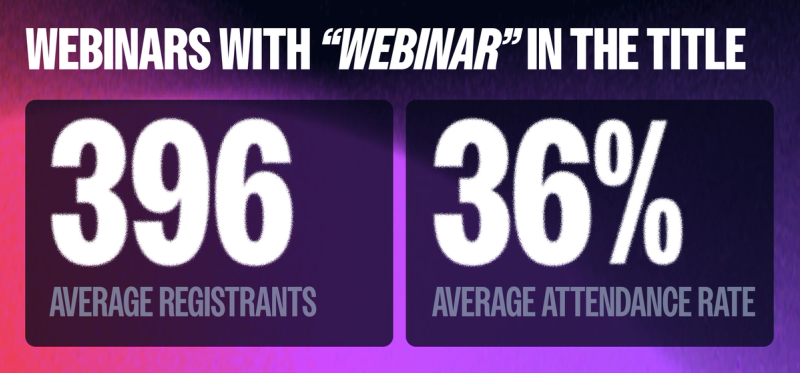
There is now a positive correlation with the use of the term "webinar" in your webinar titles — a significant one, in fact. Webinars that used "webinar" in the name saw a 66% increase in registrations and a 9% boost in attendance. That's a lot more butts in seats on the day of the event.
What changed?
It's clear that webinars have gotten a makeover, and for good reason. The webinar experience is worlds away from what it was a few years ago, when people were complaining about Zoom fatigue and loathe to sign up for yet another boring virtual meeting.
Today's webinars are interactive, engaging, and polished. The audio is clear, the visuals are crisp, and the chat is popping. Audiences have come to expect great things from webinars, and we're certainly here for the reinvention.
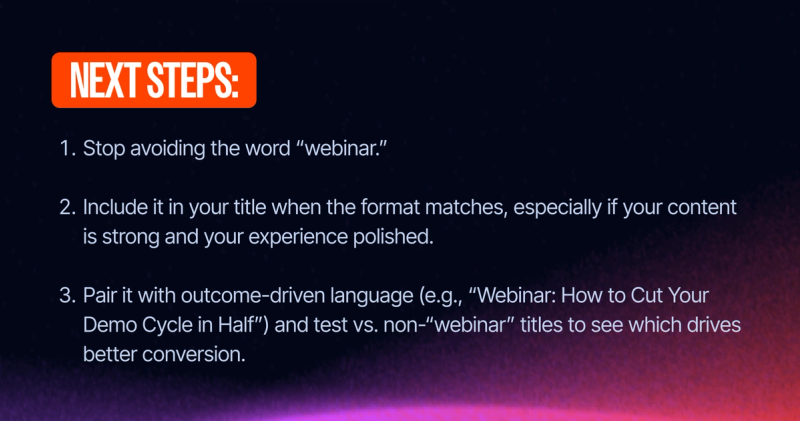
Webinar engagement
Engagement refers to how people participate during your webinar. Are folks active in the chat, asking questions, and reacting to polls? Those are all great signs of engagement.
The level of audience engagement is directly correlated with the overall success of your event. When people give you not just their time but their energy and attention, it's a signal that your content resonates with them. We've also seen that engaged attendees are more likely to talk about your event — and your brand — to others.
Engagement data is a direct line to what your audience cares about.
If an event gets low engagement, perhaps it's worth evaluating that topic and whether it's relevant to your audience. If a topic in the chat causes a lot of controversy, that could be a good future webinar (or series) idea.
Goldcast engagement features and usage
Goldcast's engagement panel includes multiple ways for attendees to interact during webinars. Here's how each feature was used across webinars in 2024:
Top Goldcast engagement features:
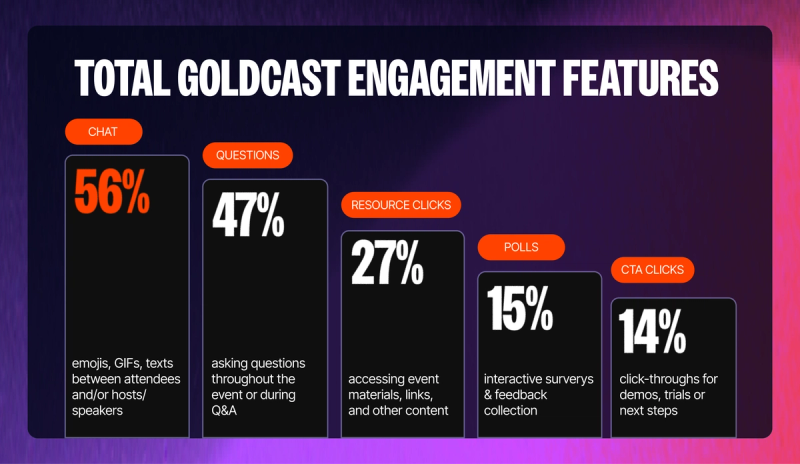
Chat has historically always been the most-used feature, with questions not far behind. Those may be a given, but we encourage you to use polls during your next webinar. They're incredibly effective for audience participation and getting feedback from people in the moment.
When we look at a single webinar event, here are the benchmark numbers we expect to see, on average.
Average engagement metrics per event:
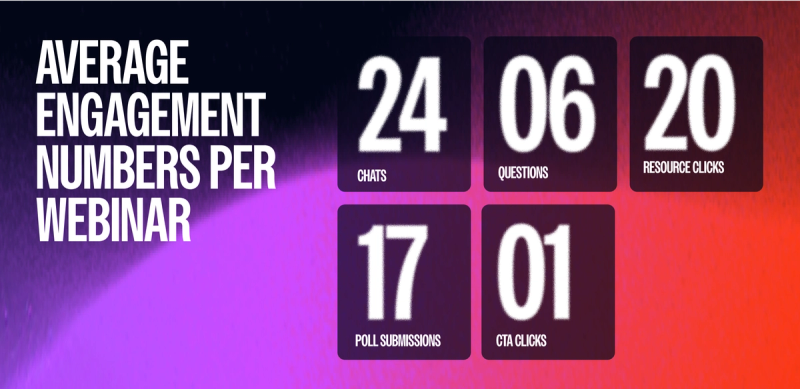
You can see that there are a significant number of resource clicks here, suggesting that attendees are eager to extend their learning beyond the webinar session. And, *ahem* — poll submissions aren't far behind.
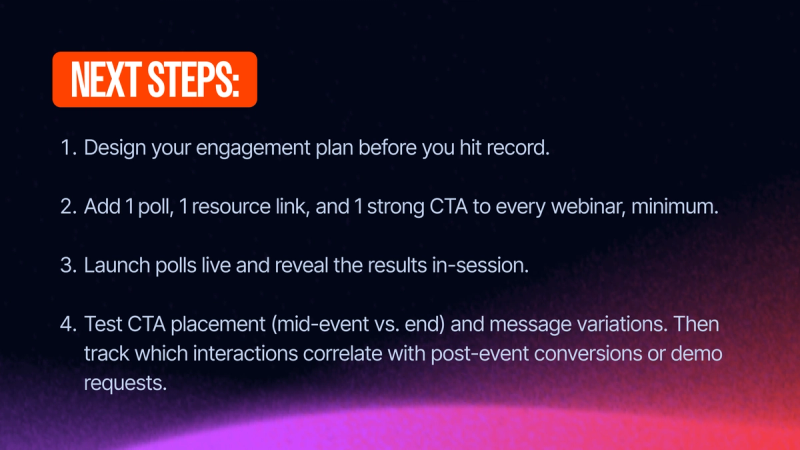
Webinar repurposing
Once you've put in the time, effort, and resources into coming up with a compelling webinar idea — and then executing on it — you've got an opportunity to get even more runway out of that event through repurposing.
Content repurposing is critical for extending webinar value and maximizing your return.
Here are some key benefits of repurposing:
- Reach bigger audiences across different platforms
- Reinforce your key messages over time
- Accommodate different content consumption preferences
- Save time and money
Don't let your webinar content waste away when the event ends. With Goldcast Content Lab, an AI-driven repurposing solution, you can turn one webinar into lasting fuel for your content machine. Video clips, social media posts, emails, and more — that one event will feed your multi-channel distribution for months.
The Content Lab numbers from 2024 show astonishing numbers when it comes to repurposing:

Total assets refers to anything produced in Content Lab, from videos to takeaway posts to email drafts. Last year, we shared some specific numbers around video clips, text assets, and formats, so let's take a look at how those have evolved next.
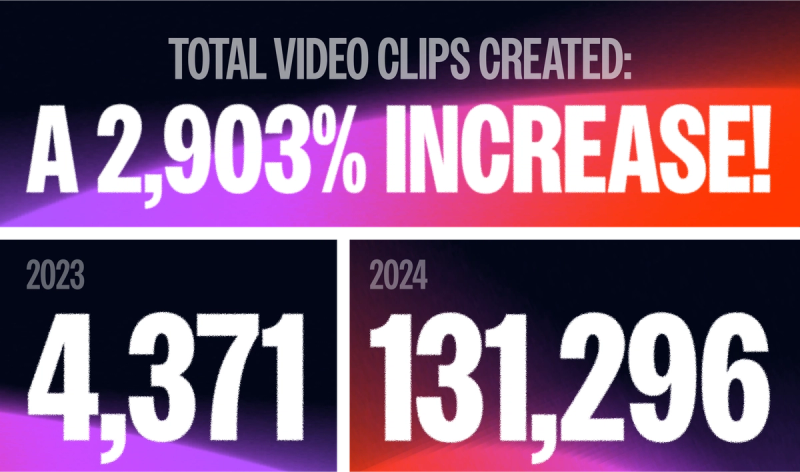
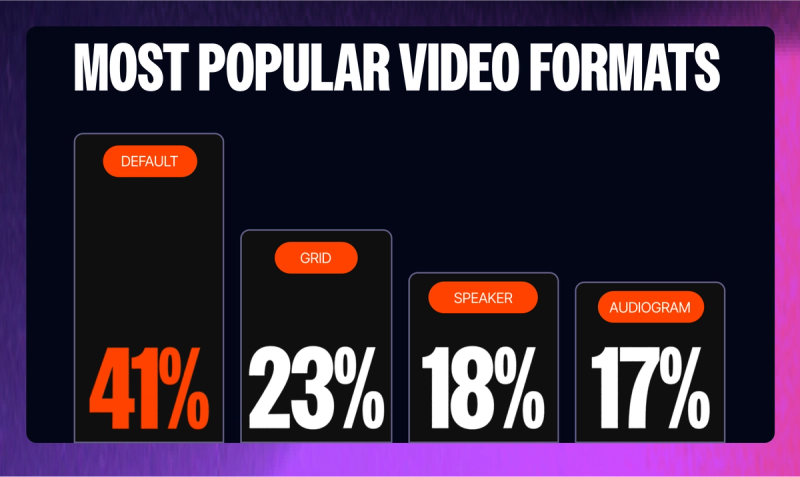
"Default" is a new video format we tracked this year, and it just means that the style of the video was left as is, and the video clip appears exactly as recorded. No speaker layout is applied, and the video isn't changed into a different style, like an audiogram.
The other change we noted this year is that audiograms appeared to gain popularity, while grid-style videos decreased in popularity by 7%.
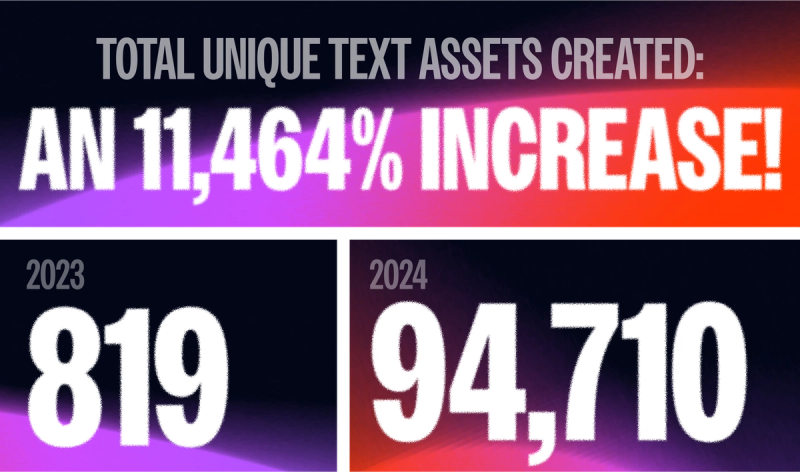
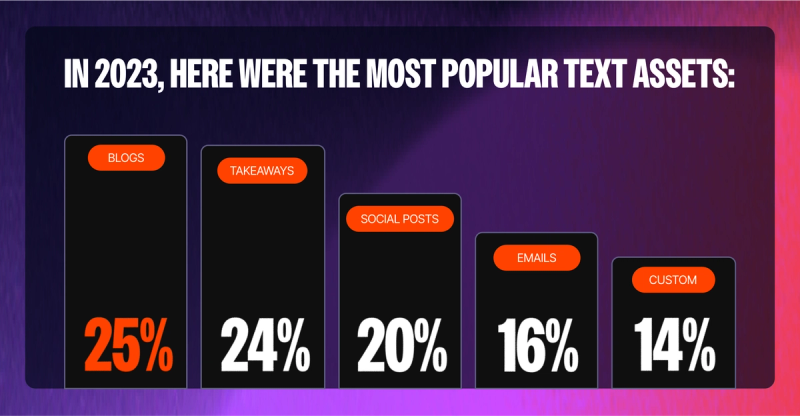
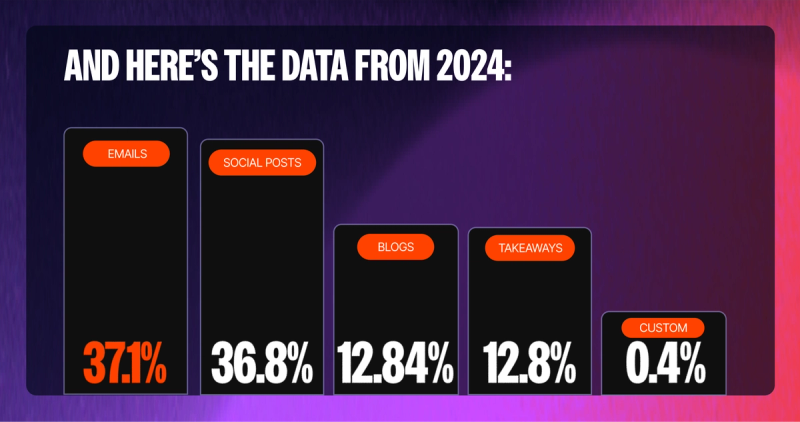
What's causing the surge in repurposing?
Lots to unpack here.
To start, obviously folks are using Content Lab to create way more video clips and text assets than ever before. The type of assets they're creating has also changed — there's been a big shift from blog-centric content to personalized emails and social posts, which we've seen here internally at Goldcast as well.
Your audience likely spends more time in their email inbox and on social than they do on blogs, so it makes sense to meet them there.
Across the B2B industry, we're also seeing a massive transition from singular-event thinking to viewing webinars as content machines. Webinars are now seen not only as a way to connect with audiences and build Mindshare, but the best route to produce enough material to fuel a lasting, comprehensive content strategy.
Tools like Content Lab have made it possible to multiply content output without having to hire new folks or outsource work to agencies. Because video is now necessary to gain — and keep — audience attention and build thought leadership, companies are turning to Content Lab to create on-brand, editable drafts in just minutes.
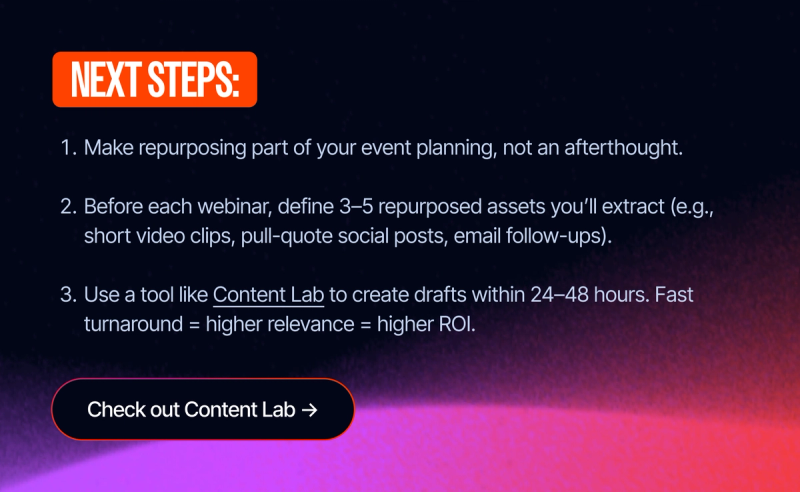
Webinar Benchmark Scorecard
We've gone over a ton of info, so we're going to recap here so you can have a scorecard to benchmark your own data against. While your results may differ depending on your company and industry, the numbers below represent the averages we saw in 2024. Plus, we offer a little planning help based on our data.
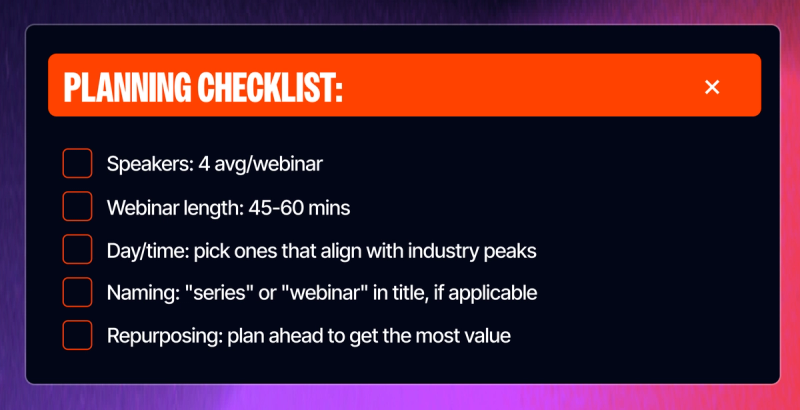
Performance benchmark metrics:
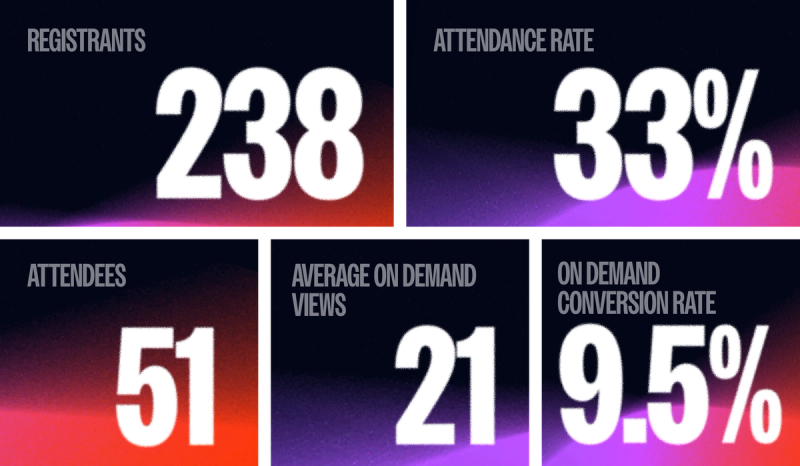
A quick look ahead: What does the future hold?
Some things held steady year over year, but we saw several huge changes in this year's report. Namely, the shift toward people wanting to sign up for webinars with "webinar" in the title and the extreme growth in repurposing.
Here's what we expect to see in the coming years, as AI technology continues to evolve along with audience expectations:
Increased personalization
When you log into any app, the experience is typically tailor-made just for you. Webinars will need to follow suit, speaking directly to individual attendee needs and interests.
With the help of AI, you can segment according to attendee behavior, role, industry, engagement history, and more. Other webinar-related personalization tactics include: customized follow-ups, bespoke invitations, AI chatbots that can speak to attendees in real time, and adjusting content throughout the live event, depending on people's input and poll responses.
CRM and sales enablement integration
Webinars are already deeply integrated with sales processes. For example, Goldcast offers integrations with HubSpot, Marketo, Salesforce Sales Cloud, and more. As this continues to expand, sales teams will receive rich behavioral data about prospects, based on their webinar attendance and behavior.
Ideally, once a person attends a webinar, they're automatically scored and sent to the sales team, and a personalized follow-up process begins. Webinars are already a major part of the lead gen function and directly contribute to pipeline growth and expansion, but we will see this more and more as the years progress.
Immersive virtual environments
Webinar platforms will continue to focus on providing engaging, interactive virtual experiences. Quality storytelling will be paramount, and marketers will plan ahead to include polls, surveys, games, quizzes, giveaways, Q&A sessions, and other elements that draw attendees in.
Improve your webinar strategy
This is truly such an exciting time for B2B marketers. The skyrocketing growth in webinar adoption — 225% year over year — combined with AI-enabled repurposing tools means it's possible to maximize both your event and content strategies with less manual work than ever before.
The data shows that consistently hosting strategic webinars is one of the key ways marketers are connecting with audiences and growing Mindshare. And, with the capabilities to host content on-demand and quickly repurpose it into other assets, each webinar delivers value long after the initial event.
Key trends
Here's a recap of the key trends we covered:
225% growth in webinars YoY
Audiences practically demand webinar content at this point, and companies are stepping up to the challenge. Driven by smarter audience segmentation, engaging promotional strategies, and scheduling around audience availability (plus on-demand capabilities), webinars have become a critical way to increase Mindshare and competitively position B2B brands.
Rise in on-demand content availability
Nearly 80% of webinars are now uploaded on demand after the event ends. This reflects audience's preferences for flexibility and allows companies to reach people outside of the registrant and attendee pools.
Content repurposing explosion
The 2,903% increase in AI-generated video clips is phenomenal stuff. Companies are finally treating webinars as the evergreen content machines we've always known they were, rather than standalone events. Marketers are actively trying to maximize every piece of content they create, and that's amazing.
Series and naming conventions
We saw there were higher attendance rates for series that called themselves "series," as well as webinars that use the word "webinar" in the title. Audiences are motivated to sign up for ongoing, clearly labeled webinar content.
What to do next
We sprinkled "next steps" throughout this report and included these as line items on our Webinar Benchmark Scorecard, but let's run through some actions you can take as soon as your next webinar.
- Optimize scheduling and format: Target the 45-60 minute length, and look at industry best times for when to schedule. Generally, consider scheduling on Tuesdays for the best mix of audience availability and less competition from other events.
- Prioritize content flexibility: Be sure that all of your content is available on demand after the event, and use short-form promotional videos to attract a wider audience to register. Consider using pre-recorded formats when you want to run the same event, multiple times, and engage folks each time.
- Launch a series: Develop ongoing webinar series to further position yourself as a brand leader, while building deeper relationships with your audience. Series programs draw 38% attendance rates, which is higher than the average benchmark of 33%.
- Harness AI for content repurposing: Scale your content efficiently using tools like Goldcast Content Lab. The reason we saw an 11,464% rise in text assets — especially emails and social posts — is all thanks to the power of AI.
- Bookmark our Webinar Benchmark Scorecard and refer to it often to see how your webinars are stacking up against industry standards.
Strategic recommendations for B2B organizations
Improving your webinar strategy requires a fundamental shift in the way your org prioritizes events and video content. The companies who will see the greatest Mindshare growth and webinar ROI are those that treat webinars as an integrated part of their marketing and sales ecosystems.
Embrace innovation
Experiment with different webinar tools and technologies like the ones we've called out here. Analyze the benchmarks we've presented here so you understand what companies average in terms of results, and then keep track of your own performance over time to see where you can improve.
Don't be afraid to ask for feedback, either. Send post-event surveys to your audience or poll them in real time to get valuable information you can use to inform your event and content strategies.
Adopt a content-first mindset
Webinars should be viewed as core strategic assets, and webinar strategy should be integrated with your overarching content marketing initiatives. Each webinar should generate multiple touchpoints across various channels and formats. Rarely — if ever — should a webinar be a one-and-done event that happens and is then never seen again.
Invest strategically in technology and creativity
Webinar success requires company-wide buy-in. Leadership must understand that compelling webinars (and the resulting repurposed content) rely on advanced content creation tools. Using AI to free marketers from doing the most laborious, time-intensive tasks means that time saved should be funneled toward creative execution that will elevate storytelling and set webinars apart from the rest.
Take the next step today
Organizations that study these trends and apply them to their webinars will see their webinars become strategic growth engines. We've seen over and over again that webinars are now far more than simple lead gen tools — they're the way to build Mindshare, establish yourself as a thought leader, and create lasting relationships with your people.
Now's the time to implement these tips, study the benchmarks, embrace the technology that's out there, and commit to treating webinars as strategic assets. Whether you're just starting out on your webinar journey or seeking to optimize your existing strategy, we're here to support you.
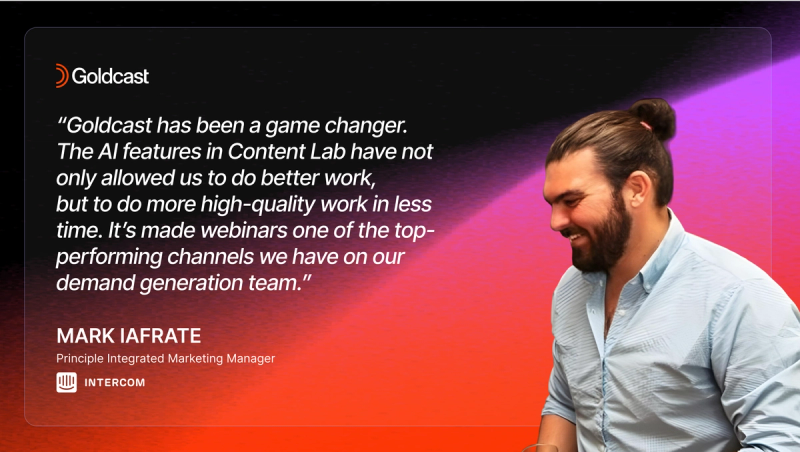
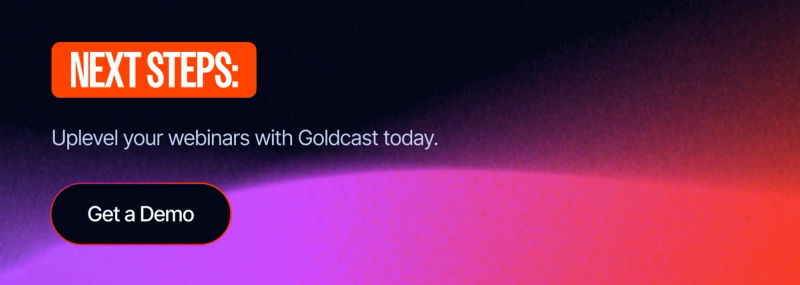
Stay In Touch
Platform
Resources
© 2025 Copyright Goldcast, Inc. All rights reserved.





 Upcoming Events
Upcoming Events Event Series
Event Series On-Demand Events
On-Demand Events